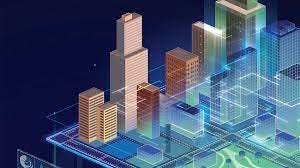Buildings produce almost 40% of carbon dioxide emissions worldwide — a whopping 7% more than cars. So when mitigating climate change, one of the biggest sectors needing reform is the urban planning industry. Thankfully, there is a solution: digital twin technology. Digital twin technology is a virtual representation of an object or a system updated in real-time using simulation, machine learning, and reasoning. In real estate, a digital twin serves as a replica of a building, neighborhood, or entire city, allowing detailed analysis and simulation of behavior. The significance of digital twins in urban development lies in their ability to reduce costs and contribute to net-zero goals. Integrating digital twin technology is a pivotal step toward revolutionizing efficiency and sustainability in urban development. It optimizes resource utilization, improves property efficiency, and reduces carbon footprint, acting as a catalyst for net-zero cities in the fight against climate change.
Cost Efficiency and Resource Optimization
Digital twin technology in real estate optimizes the utilization of resources like energy, space, water, and utilities. Through data collected via sensors, energy consumption trends can be determined, bottlenecks can identified, and resources allocated. This enables proactive decisions for maximum energy efficiency. Digital twins can also simulate different scenarios to identify underutilized areas and optimize heating, cooling, and lighting systems. In real-world applications, this means that when nobody is in a room, heating and lights can be automatically turned off to avoid wasted energy. According to surveys, companies that leveraged digital twins experience energy savings of up to 25%.
Along with this, digital twins also revolutionize the management of buildings, because saving on energy directly equates to saving on property costs. Companies implementing digital twin technology have seen an average of 13% reduction in maintenance costs. This is a significant amount of money and energy that can be saved because of digital twin technology.
Carbon Footprint Reduction
Digital twins play a crucial role in the global endeavor to reduce carbon footprints and decarbonize our cities. These digital twins use data from physical sensors to simulate, track, and monitor the real-world environment. Their applications span diverse sectors, from oil and gas to buildings and infrastructure. This data-driven approach offers precise insights into emission hotspots, a critical aspect as cities contribute a staggering 60% to greenhouse gas emissions while consuming 78% of the world’s primary energy.
The global economy is rallying behind ambitions to achieve a Net Zero World by 2050, with 296 countries signing the Paris Agreement, a binding treaty to limit global warming. Digital twins decrease greenhouse gas emissions by up to 50% in existing buildings while achieving cost savings of up to 35%. Entire nations are endorsing digital twins as a tool to achieve this goal — Singapore and the United Kingdom have launched their own digital twin initiatives.
Case Studies
Cities worldwide are recognizing the transformative potential of integrating digital twins into their urban landscapes. For example, Singapore, a nation grappling with flash floods and the complexities of land scarcity, used the digital twin concept to create Virtual Singapore, the first digital twin of an entire country. This comprehensive virtual replica aids asset management, decision-making, and urban planning. Its implementation highlights the tangible and extensive benefits that digital twins can bring to the forefront of infrastructure development, offering solutions to real-world challenges.
Likewise, the United Kingdom’s Digital Twin Program is an initiative that seeks to leverage digital twin technology for sustainable urban development. This program is a prime example of how digital twins go beyond individual projects, becoming catalysts for innovation and efficiency on a national level. Through a collaborative and integrated approach, it showcases how nations can use digital twins to drive sustainability efforts and enhance the efficiency and resilience of their urban environments.
Challenges and Considerations
Creating digital twins is very expensive. It’s a significant financial investment, especially when incorporating them into older buildings. For example, crafting a digital twin for a standard office building costs between $1.2 and $1.7 million. And for a larger, more complex building, like a hospital, it costs around $3 to $4.2 million. This great financial burden poses a challenge to widespread implementation, particularly for small-scale building owners who may be unable to pay that price.
Although the initial costs are high, the investment leads to significant long-term savings on maintenance expenses. So really, it’s more of a strategic investment that offers lasting benefits, once you get past the cost. In essence, the upfront expense leads to enduring efficiency, future financial gains, and a healthier built environment.
Future Prospects
The global digital twin market is expected to reach $50 billion by 2030, reflecting its increasing relevance and adoption across industries. With a compound annual growth rate of 42.6%, digital twins are poised to become integral in urban planning, infrastructure development, and resource management globally. People are generally optimistic about the potential of digital twins and all they can achieve. After all, they enable sustainable practices, streamline management processes, and optimize resources. Along with this, their growth is driven by the increasing adoption of digital twins in a multitude of industries, like real estate, as well as advancements in technologies such as artificial intelligence.
In summary, digital twin technology is redefining urban development and real estate practices, offering transformative benefits. From optimizing resource utilization and improving property management to contributing to sustainability goals, digital twins represent a powerful tool for shaping smarter and more efficient cities. Case studies, such as Singapore and the UK's National Digital Twin program, highlight real-world successes and a global push to adopt this new technology. Despite some challenges, the anticipated market growth underscores the increasing recognition of digital twins' potential impact. As we navigate the era of digital transformation, digital twins emerge as a crucial driver toward creating resilient, sustainable, and innovative urban landscapes.



